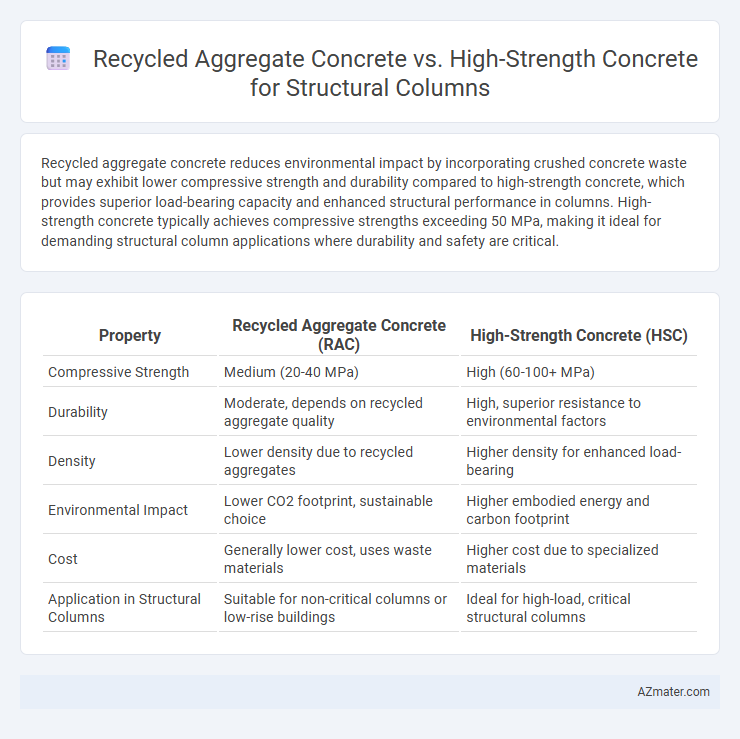Recycled aggregate concrete reduces environmental impact by incorporating crushed concrete waste but may exhibit lower compressive strength and durability compared to high-strength concrete, which provides superior load-bearing capacity and enhanced structural performance in columns. High-strength concrete typically achieves compressive strengths exceeding 50 MPa, making it ideal for demanding structural column applications where durability and safety are critical.
Table of Comparison
| Property | Recycled Aggregate Concrete (RAC) | High-Strength Concrete (HSC) |
|---|---|---|
| Compressive Strength | Medium (20-40 MPa) | High (60-100+ MPa) |
| Durability | Moderate, depends on recycled aggregate quality | High, superior resistance to environmental factors |
| Density | Lower density due to recycled aggregates | Higher density for enhanced load-bearing |
| Environmental Impact | Lower CO2 footprint, sustainable choice | Higher embodied energy and carbon footprint |
| Cost | Generally lower cost, uses waste materials | Higher cost due to specialized materials |
| Application in Structural Columns | Suitable for non-critical columns or low-rise buildings | Ideal for high-load, critical structural columns |
Introduction to Structural Columns: Material Choices
Structural columns require materials with high load-bearing capacity and durability to ensure building stability and safety. Recycled aggregate concrete offers environmental benefits and cost savings by incorporating sustainable materials without significantly compromising strength. High-strength concrete provides superior compressive strength and density, making it ideal for columns subjected to heavy loads and demanding structural performance.
Overview of Recycled Aggregate Concrete (RAC)
Recycled Aggregate Concrete (RAC) utilizes crushed concrete waste as aggregate, promoting sustainability and reducing environmental impact in structural columns. This concrete type exhibits lower density and slightly reduced mechanical properties compared to traditional aggregates but offers satisfactory compressive strength for non-critical columns. Advances in mix design and treatment of recycled aggregates enhance durability and bond strength, making RAC a viable choice for eco-friendly construction applications.
Overview of High-Strength Concrete (HSC)
High-strength concrete (HSC) is defined by its compressive strength exceeding 40 MPa, offering superior load-bearing capacity for structural columns compared to conventional concrete. HSC's dense microstructure enhances durability, reduces permeability, and improves resistance to chemical attacks, making it ideal for high-rise buildings and infrastructure requiring long service life. Its mix design often includes low water-cement ratios, supplementary cementitious materials, and high-quality aggregates to achieve optimal performance in structural applications.
Environmental Impact: Sustainability Considerations
Recycled aggregate concrete significantly reduces environmental footprint by lowering natural resource extraction and minimizing construction waste sent to landfills. High-strength concrete, although offering superior load-bearing capacity and durability for structural columns, typically requires higher cement content, leading to increased CO2 emissions. Prioritizing recycled aggregate concrete aligns with sustainable construction goals, promoting resource efficiency and reducing greenhouse gas emissions in structural projects.
Mechanical Properties: Strength and Durability
Recycled aggregate concrete (RAC) typically exhibits lower compressive strength and increased porosity compared to high-strength concrete (HSC), impacting its structural performance in columns. High-strength concrete offers superior mechanical properties, including higher compressive strength often exceeding 60 MPa and enhanced durability due to reduced permeability and improved resistance to environmental degradation. The durability of structural columns made from HSC is generally greater, with better resistance to corrosion and freeze-thaw cycles, whereas RAC requires careful mix design and quality control to approach comparable long-term performance.
Workability and Construction Practices
Recycled aggregate concrete exhibits lower workability compared to high-strength concrete due to the irregular shape and higher absorption of recycled aggregates, necessitating adjustments in mix design and use of admixtures to achieve desired consistency. High-strength concrete typically offers better workability with controlled water-cement ratios and advanced admixtures, facilitating smoother placement and compaction in structural columns. Construction practices for recycled aggregate concrete require careful monitoring of moisture content and on-site handling to maintain uniformity, whereas high-strength concrete demands precise curing and formwork techniques to ensure strength development and durability.
Cost Analysis: RAC vs HSC
Recycled aggregate concrete (RAC) significantly reduces material procurement costs by utilizing construction waste, lowering expenses compared to conventional high-strength concrete (HSC). HSC incurs higher costs due to specialized admixtures and quality aggregate materials required to achieve compressive strengths above 60 MPa, increasing the overall project budget. Lifecycle cost analysis of structural columns shows RAC offers cost savings in raw materials and disposal fees, while HSC may require less maintenance and repair over time, balancing initial investment against long-term durability.
Structural Performance and Load-Bearing Capacity
Recycled aggregate concrete exhibits comparable structural performance to conventional concrete but typically demonstrates lower load-bearing capacity compared to high-strength concrete in structural columns. High-strength concrete significantly enhances load-bearing capacity due to its superior compressive strength, making it ideal for high-demand structural applications. The use of recycled aggregates may reduce mechanical properties; however, with proper mix design and treatment, it offers sustainable alternatives without severely compromising the structural integrity of columns.
Case Studies and Real-World Applications
Case studies on recycled aggregate concrete (RAC) for structural columns demonstrate its viability in sustainable construction, with successful applications in low to medium-rise buildings showing comparable load-bearing capacity and durability to conventional concrete. High-strength concrete (HSC) is frequently used in high-rise and infrastructure projects, offering superior compressive strength above 70 MPa, enabling slimmer column profiles and greater architectural flexibility. Real-world applications highlight RAC's environmental benefits through reduced natural resource depletion and CO2 emissions, while HSC's enhanced mechanical properties support demanding structural requirements in seismic zones and heavy load conditions.
Recommendations for Optimal Concrete Selection
Recycled aggregate concrete offers enhanced sustainability benefits but may require adjustments in mix design to achieve comparable durability and load-bearing capacity to high-strength concrete, especially for structural columns. High-strength concrete provides superior compressive strength and reduced permeability, making it preferable for columns subjected to heavy loads or harsh environmental conditions. For optimal selection, consider project-specific factors such as structural requirements, environmental impact goals, and long-term performance, recommending recycled aggregate concrete for moderate load conditions and high-strength concrete for critical structural applications.

Infographic: Recycled aggregate concrete vs High-strength concrete for Structural column
 azmater.com
azmater.com